Pump Handbook by Igor J. Karassik, Joseph P. Messina, Paul Cooper, Charles C. Heald - 3rd edition
Подождите немного. Документ загружается.


6.2.1 EDDY-CURRENT COUPLINGS 6.105
FIGURE 7 Interconnection block diagram of eddy-current clutch and speed control
Enclosures available will vary depending on the type of cooling involved. Obviously
water-cooled types need little if any enclosure adaptation for virtually any installation.
However, caution should be exercised in outdoor use where freezing can occur. Also, verti-
cal installations utilizing water cooling may require special considerations.
Air-cooled couplings are more universally used for centrifugal pump loads but do require
attention on enclosure design. Indoor installations in clean atmospheres need only open or
drip-proof enclosures where heat rejection is not a problem. In some cases, intake and dis-
charge covers for connection to ductwork may be necessary for environmental isolation.
Weather-protected enclosures are available for outdoor installations, A NEMA Type I
rating is normally adequate because of the slip coupling’s inherent mechanical design and
relatively low field winding voltage levels.
CONTROLS _________________________________________________________
The speed control is designed to operate with a magnetic drive equipped with a magnetic
pickup. The controller contains a signal isolator to allow precise speed adjustment from
an automatic 4
—
20 ma (milliamperes) of 0
—
10 VDC (volts DC) control signal. The control
has a closed loop control circuit, field firing circuit, current feedback loop, and SCR (silicon-
controlled rectifier) power stage for controlling the output speed of the magnetic drive.
The control also has an acceleration/deceleration ramp circuit that is an integral part of
the control circuit for smooth acceleration of the load
—
especially important for many
types of pump loads.
The input signal is fed through an isolation circuit or from the manual speed adjust-
ment pot to the controller circuit. The controller circuit outputs a regulated voltage and
current to the field firing circuit. This voltage/current output is also regulated by the cur-
rent feedback sensed by the resistor network and the speed signal from the magnetic
pickup to assure precise speed regulation. The field firing circuit regulates the firing tim-
ing of the SCRs. By using multiple loopback feedback circuits, speed regulation is held
with .2% of the set speed.
6.106 CHAPTER SIX
The controller circuit has a current limiting adjustment that controls the maximum
current from the SCR circuit to the drive field to eliminate any excess current in the drive
coils. This protects from overpowering the drive and causing unnecessary heating.
The controller power circuits convert 120
—
480 VAC (volts AC) into DC voltage.The DC
voltage is converted to the required voltage of the drive field by the SCR firing circuit
using pulse width modulation. The circuits are protected by circuit breakers and metal
oxide varistors.
APPLICATIONS ______________________________________________________
Slip couplings are applied to centrifugal pumps for water and waste-water pumping in
municipal installations, for boiler-feed pumping, for circulating water and condensate
pumping in power plants, for fan and stock pumping in paper mills, and for reciprocating
pumping in a multitude of applications and industries.
In the water and waste-water fields, slip couplings are used extensively for raw- and
finished-water pumping, lift-station pumping, raw-sewage pumping, and effluent and
sludge pumping. Almost any pumping problem, where cyclic constant-speed pumping or
throttling or other means of flow control are alternate considerations, can be conveniently
solved with the use of an eddy-current slip coupling as the adjustable-speed flow control-
ling device.
Potable water treatment and distribution facilities are continually confronted with
substantial fluctuations in demand through daily, weekly, and even seasonal periods. Dis-
tribution systems that depend on direct pumping usually must utilize total or partial
adjustable speed operation for high-service and booster requirements.The quick response
of eddy-current slip couplings makes them extremely well suited for this duty.
Waste-water collection systems, where inflow conditions to lift stations and treatment
plants vary widely throughout the day, can realize many advantages when designs are
based on adjustable speed with eddy-current slip couplings.
RATINGS AND SIZES _________________________________________________
Eddy-current couplings are available in a wide range of ratings and sizes, from fractional
power units up through 10,000 hp (7500 kW) and beyond. The type of cooling employed is
an important consideration; some manufacturers use either water or air exclusively and
others use a combination of the two. In addition, the type of load is a factor because ther-
mal capability will vary significantly between water- and air-cooled units.
Centrifugal pump variable-torque loads are usually best handled by air-cooled cou-
plings having high-torque capabilities at low slip values and limited heat-dissipating
capabilities.The selection chart shown in Table 1 is representative of one manufacturer’s
line of couplings designed specifically for centrifugal pump loads. Where full-torque
capabilities are realized at 3% slip below motor speed, thermal loads at two-thirds of
motor speed will be 16.2% of rated speed load power. Sizes starting at 3 to 5 hp (2.2 to
3.7 kW) and extending up through 3000 to 5000 hp (2240 to 3730 kW) are generally
available.
Eddy-current couplings for pump loads requiring constant-torque drives have rather
limited usage. In small sizes where thermal capabilities are proportionately greater than
the 6:1 ratio encountered on large units, constant-torque loads can be adequately handled
by air-cooled couplings. Beyond 100 hp (75 kW), air-cooled units can be impractical
because of thermal and starting-torque requirements.
Water-cooled eddy-current couplings have somewhat different characteristics, making
them more suitable for constant-torque and large-power variable-torque loading. High
starting torque, high minimum slip, and high thermal capabilities all tend to lead to those
conclusions. Thermal capabilities are frequently equal to or greater than full-load power
ratings. The starting torque is usually the maximum torque, and as a result low slip val-
ues are limited.
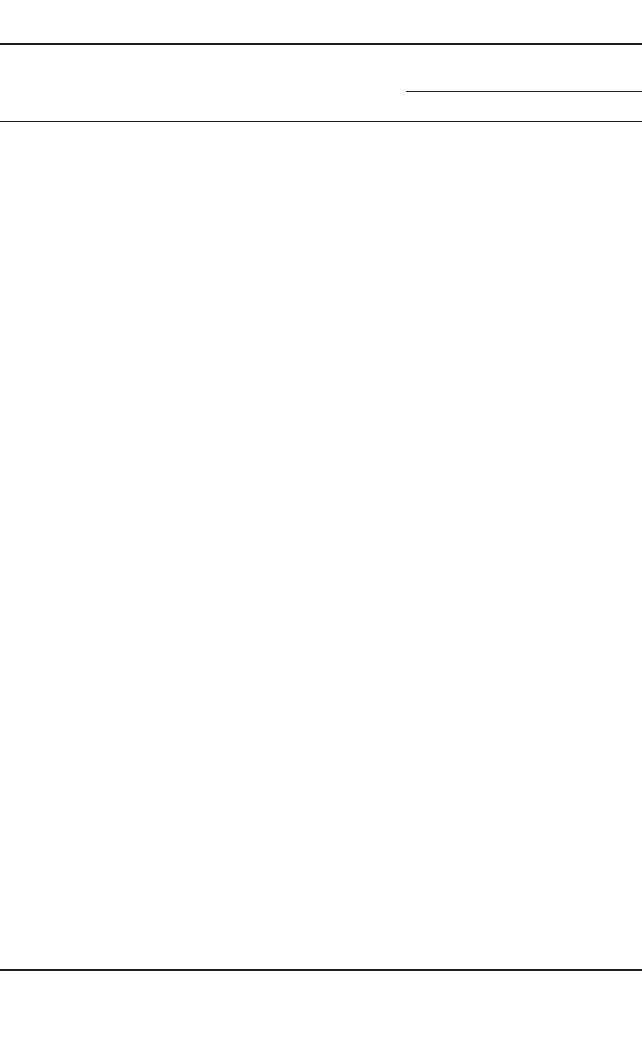
6.2.1 EDDY-CURRENT COUPLINGS 6.107
TABLE 1 Eddy-current coupling selection chart for centrifugal pumps, horsepower
output (1hp = 0.746 kW)
Percent of motor full-load speed
Drive motor input speed, rpm Unit Size 99 98 97 96
1750 S209 370 420 405 395
S238 630 610 597 579
S276 820 800 775 750
S326 1150 1100 1065 1030
S376 1800 1750 1700 1650
1150 S209 160 290 305 295
S239 400 470 455 442
S276 440 615 600 580
S326 910 870 844 818
S376 1300 1270 1230 1190
870 S209 100 170 225 240
S239 250 336 375 364
S276 300 355 490 480
S326 650 718 696 675
S376 1100 1080 1050 1000
700 S209 160 185
S238 200 210
S239 170 250 316 316
S276 250 310 365 375
S326 420 580 597 579
S376 950 920 900 860
585 S209 110 135
S238 140 160
S239 223 270
S276 240 270 280
S326 300 510 520 507
S376 430 610 600 576
495 S209 100
S238 135
S239 200
S276 205 235
S326 220 380 410 460
S376 740 710 700 670
435 S209 80
S238 115
S239 167
S276 190
S326 170 310 330 390
S376 640 670 650 630
385 S276 150
S326 275 320
S376 530 600 585 565
S448 650 950 1000 980
S529 1650 1790 1750 1680
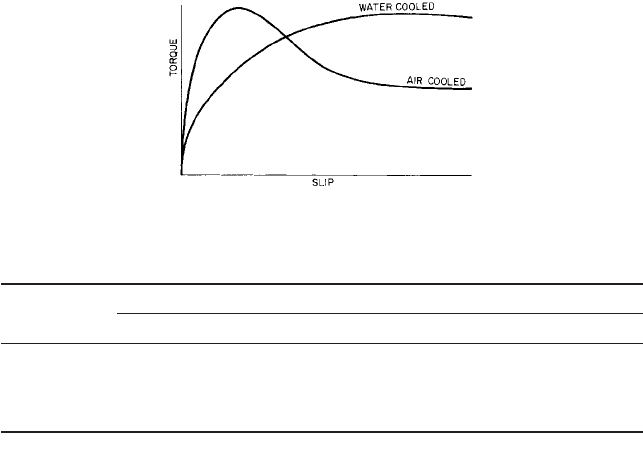
6.108 CHAPTER SIX
FIGURE 8 Speed-torque curves for variable-torque air-cooled and constant-torque water-cooled couplings
TABLE 2 Typical eddy-current coupling downthrust capabilities, lb
a
Motor speed, rpm
Unit size 1,750 1,150 870 700 585 495
S209 2,920 3,530 4,080 4,580 4,860 5,180
S239 2,240 2,860 3,410 3,910 4,190 4,500
S276 3,900 4,605 5,170 5,670 6,150
S326 2,545 3,260 3,810 4,290 4,780
a
1 lb 4.45 N.
Figure 8 illustrates the differences in the speed-torque curves of variable-torque air-
cooled and constant-torque water-cooled couplings.
THRUST CAPABILITIES FOR VERTICAL UNITS____________________________
Most vertical eddy-current couplings have limited external downthrust load capabilities
when provided with standard bearing arrangements. Typical values are listed in Table 2
for the sizes listed in Table 1. Bearing life is an important factor, and the values shown are
based on a minimum life of five years in accordance with manufacturer’s standards at an
average output speed of 85% of input speed. Bearings are angular-contact ball type with
grease lubrication. Where higher thrust values are encountered or where longer bearing
life or adherence to ABMA life standards must be met, spherical roller bearings or plate-
type hydrodynamic thrust bearings with oil lubrication can be furnished.
6.2.2
SINGLE-UNIT
ADJUSTABLE-SPEED
ELECTRIC DRIVES
E. O. POTTHOFF
J. R. HENDERSHOT
6.109
In past years, the electric motor industry has been dominated by the use of essentially sin-
gle and constant speed motors when line fed. There were many mechanical methods used
to achieve adjustable speed using a single-speed prime mover. There was also widespread
use of dc motors for adjustable speed over the last century because only the voltage must
be adjusted for speed change.Although operation at speeds well below synchronous can be
accomplished through adjustment of the secondary resistance in wound-rotor induction
motors, the ubiquitous squirrel-cage ac induction motor requires the adjustment of the fre-
quency to change speed.This was not so easily accomplished until the recent utilization of
pulse width modulation (PWM) inverters with insulated gate bipolar transistors (IGBTs)
for power transistors plus microprocessors.
Electric drives are available featuring a single rotating element and some associated
control for performing the adjustable-speed driving function. The use of a single rotating
element differentiates this type of drive from the eddy-current coupling motor, hydraulic
coupling motor combinations, and adjustable-speed belt drives, all of which are tandem
drives.
The speed of the single-unit adjustable-speed drive is controlled through the interac-
tion of the control and the motor. For this reason, one must consider these two elements as
a drive and not consider the motor alone.
Subsection 6.1.1 described motors that will be further discussed in this subsection. Pre-
vious discussions of control were limited to that required for starting and protection; this
subsection will also describe specific controls required for speed control. The discussion
will cover the following types of drives:
• Ac adjustable-voltage drives
• Wound-rotor induction motors with several different types of secondary controls
• Adjustable-frequency drives
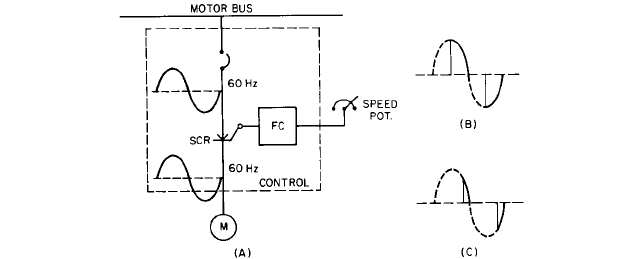
6.110 CHAPTER SIX
FIGURE 1A through C Block diagram for ac adjustable-voltage drive (General Electric)
• Modified Kraemer drives
• Dc motors with silicon-controlled rectifier (SCR) power supplies
All have physical features, operating characteristics, or prices that make them partic-
ularly valuable in some specific segment of the pump driver spectrum.
ALTERNATING-CURRENT ADJUSTABLE-VOLTAGE DRIVES _________________
This drive consists primarily of an adjustable voltage, constant frequency control, and a
motor (M) conveniently configured as shown in Figure 1.The motor must possess high slip
characteristics and other characteristics that allow it to work successfully with the asso-
ciated control. The motor is designed for operation and tested with its associated control.
Because the motor has high slip characteristics, insulation is of Class F rating.
The fundamental parts of the control are a circuit protective device, such as a circuit
breaker, an SCR assembly, and firing circuitry, identified as FC in Figure 1. Other parts
are required to complete the control but serve as auxiliaries. The main function of this
control is to provide a voltage to the motor at a level that will ensure a desired motor
speed. The control also protects the motor under abnormal operating conditions and the
motor cable under short-circuit conditions and provides a current-limit function so the
motor draws a maximum of some preselected value, such as 150% of normal, under all
operating conditions.
The SCR receives impressed voltage, usually at 60 Hz. The SCR can be turned on (or
become conducting) by means of current pulses received from the firing circuits that ener-
gize the circuits at different points on the sinusoidal wave. After conductance starts, it con-
tinues until voltage disappears at the end of the half-cycle.The SCR must be pulsed again
in order to become conducting.This occurs while the voltage is in the negative phase of its
sinusoidal generation and is performed by an SCR connected in parallel to the first and
having reverse polarity. The negative loop conductance continues until the voltage again
returns to zero. The firing controls are designed to turn the SCR on repetitively sometime
during each voltage half-cycle. Figure 1A shows the shape of the applied voltage between
the SCR and the motor for the wave illustration shown. In this case, the SCR is turned on
at the beginning of each half-cycle.
By delaying the firing, or turning on, of the SCR until later in voltage generation,
shorter intervals of applied voltage and lower levels of voltage appear across the motor.
The solid line of Figure 1B illustrates applied motor voltage when the voltage half-wave
is half-completed. Figure 1C illustrates the motor-applied voltage when the half-waves are
approximately 75% completed. Notice in these illustrations that the frequency of the volt-
age applied to the motor does not vary; only the voltage magnitude does.
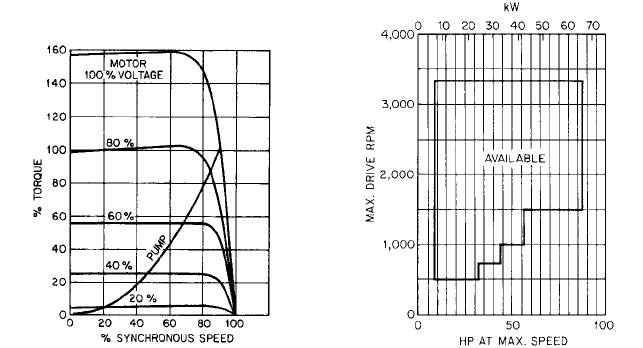
6.2.2 SINGLE-UNIT ADJUSTABLE-SPEED ELECTRIC DRIVES 6.111
The exact point in the half-wave when firing occurs is controlled by a low-energy elec-
tronic signal that may come from a potentiometer, as in Figure lA, or from some process
instrument signal. By increasing the signal level, voltage applied to the motor increases;
on the other hand, a decrease in signal level decreases the voltage level.
Figure 1A shows the SCR on the utility side of the motor as a convenience in illustra-
tion. In reality, the SCR is generally placed at the motor neutral point. This reduces volt-
age from the SCR to ground and allows the motor impedance to protect the SCR somewhat
from damage caused by transient voltage spikes entering from the electric utility line.
However, placing the SCR at the motor neutral point does require the use of six motor con-
ductors instead of the conventional three.
Figure 2 illustrates representative motor speed-torque curves at rated and other volt-
ages as well as a pump speed-torque curve varying as the square of the speed. The motor
possesses approximately 10% slip under rated torque and voltage conditions. Note that
motor torque does not break down at speeds lower than breakdown torque speed. These
various characteristics help to identify the motor as one designed to operate specifically for
this application. Note that by reducing applied motor voltage, motor torque decreases,
causing the pump to operate at lower speed.
Ratings of these drives are limited essentially to low power levels. Figure 3 provides a
guide to those available in open construction only. All ratings with maximum rated speeds
existing within the solid envelope are available. Some, but very few, are available outside
of this envelope. Totally enclosed motors are more restricted in supply than open motors
and are limited to approximately 40 hp (30 kW) maximum. In addition to these restric-
tions, load torques must not exceed values varying as the square of the speed; thus this
drive is not a candidate for driving a constant-torque load. Table 1 gives some pertinent
application information.
WOUND-ROTOR INDUCTION MOTORS___________________________________
Liquid Rheostat Controls
This form of drive consists primarily of a full-voltage, non-
reversing (FVNR) starter, a wound-rotor induction motor, and a liquid rheostat, all of
which integrate into a configuration as illustrated in Figure 4.The FVNR starter switches
power to and from the motor stator as well as provides generally accepted protection to
FIGURE 3 Availability of ac adjustable-voltage
drives
FIGURE 2 Torque versus speed for ac, adjustable-
voltage drive (General Electric)
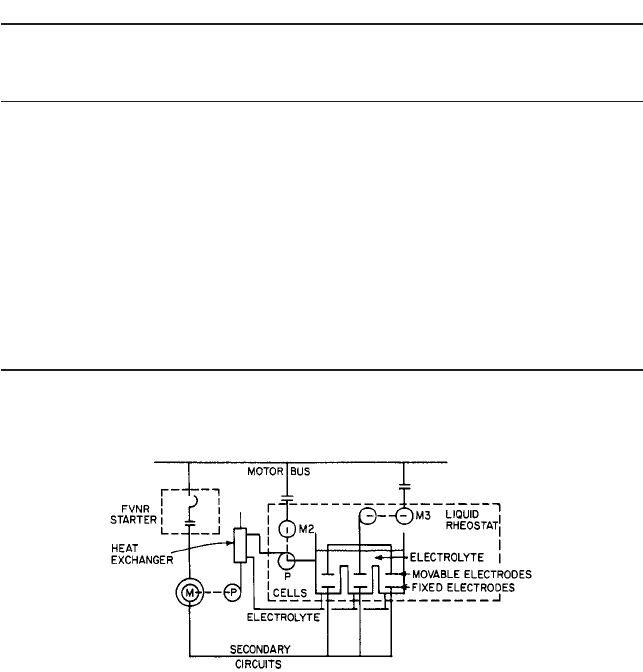
6.112 CHAPTER SIX
TABLE 1 Alternating-current adjustable-voltage drive data
No. of
Drive Voltage Max rated Speed speed
element Power rating
a
rating speed, rpm range, % Enclosure Mounting points
Motor See Figure 3 for open 200 1640 100 Vertical: Vert. Infinite
frame ratings; 230 1095 shielded or
limited availability 460 820 drip-proof; horiz.
outside these 655 TEFC not
limits 545 generally
& available
others
Totally enclosed Horizontal:
ratings limited as drip-proof,
shown under TEFC to
Enclosure 40 hp
(30 kW)
approx.
Control 5
—
150 hp 200 . . . . . . NEMA 1 Wall or Infinite
(3.7
—
112 kW) 230 NEMA 12 floor
460
a
Drive is capable of operating with power varying as the cube of speed maximum. Specifically, these ratings are
not suitable for constant-torque applications.
FIGURE 4 Block diagram for wound-rotor induction motor with liquid rheostat secondary power (General
Electric)
the motor from short circuits, overloads, and so on. Secondary cables connect the motor
rotor and fixed electrodes in the liquid rheostat. The fixed electrodes exist in separate cells
of the rheostat, one for each phase. Movable electrodes, one located in each cell, are sus-
pended from a horizontal bar, and this bar, the vertical-electrode suspension bars, the mov-
able electrodes, and the electrolyte filling the cells complete the Y, or common point in the
external motor rotor circuit. When the upper electrodes are moved up or down, the sec-
ondary circuit resistance of the drive varies and this causes a change in the motor speed-
torque characteristic.
As already pointed out, the motor starter provides the normal protective functions for
the motor. Control circuitry allows the motor to be started with maximum secondary resis-
tance in the rotor circuit, thus drawing minimum motor current from the power supply.
Figure 4 illustrates a motor (M3) operating a pulley that changes the position of the
movable electrode. This motor could be controlled manually by a push button or automat-
ically through a controller position providing either a raise-lower or modulated voltage sig-
nal. If desired, a pneumatic cylinder may substitute for motor M3 to provide power to
move the electrodes.
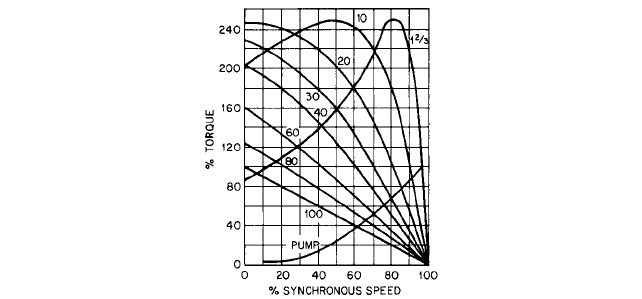
6.2.2 SINGLE-UNIT ADJUSTABLE-SPEED ELECTRIC DRIVES 6.113
FIGURE 5 Torque versus speed for wound-rotor induction motor with variable secondary resistance (General
Electric)
The electrolyte receives the drive slip losses dissipated in each of the cells, and of
course this heat must be removed into some heat sink capable of dissipating it. In some
installations, an electrolyte pump driven by motor M2 circulates the electrolyte through a
heat exchanger before returning it to the individual cells. Returning cooled electrolyte re-
enters the cells under the fixed electrodes and passes through holes in the electrodes
before passing vertically through the cells.The heat exchanger primary coolant can be tap
water or mill water, which provides a good means of passing drive slip losses as heat
directly out of the station, or it can be the pump discharge water, which conveys heat
directly away from the building, as illustrated in Figure 4.
The liquid rheostat is factory-assembled with the rheostat, electrolyte pump, and its
motor and electrode-positioning assembly packaged in a single steel enclosure suitable for
control lineups except for ratings above 700 hp (522 kW). The heat exchanger may be of
the sleeve (or wrap-around) type, as illustrated in Figure 4, and comes as a separate device
to be attached to station effluent piping. Other forms of exchangers, such as liquid-to-air
or shell- and-tube heat exchangers, are available.
Changing the position of the movable electrode results in a change in motor speed-
torque relations, as shown in Figure 5. Each curve shown (except the pump curve)
represents a motor characteristic for a discrete secondary resistance. Notice the number
associated with each curve; it represents the percentage of secondary resistance exter-
nal to the motor rotor; 100% ohms provide 100% motor torque at zero speed. In examin-
ing individual curves, note that as the percent resistance increases, the slope of the
motor speed-torque curve decreases, thus allowing the motor to slide down the pump
speed-torque curve and assume a lower speed.
This drive utilizes resistance only in the motor secondary circuit as a means of con-
trolling speed. Reactance is available as a substitute for resistance in other forms of sec-
ondary controllers, but its use reduces the drive power factor and thereby increases motor
current, reduces efficiency, and increases motor heating. As a further effect, the additional
motor current may require the use of a larger motor frame to accommodate it.
Figures 6A, B, and D provide clues to the availability of enclosed vertical and horizon-
tal wound-rotor induction motors. Figure 6A illustrates the point that vertical, totally
enclosed wound-rotor induction motors are not generally available but may be available in
random powers and speeds. Totally enclosed water-to-air-cooled (TEWAC) construction
becomes available at some minimum point as illustrated. In large ratings, shown on the
right, TEWAC construction becomes very important as it provides a convenient way of
capturing motor losses and expelling them in cooling water external to the building. Both
curves of Figure 6A terminate at 1800 rpm synchronous speed because higher speed rat-
ings are generally unavailable.
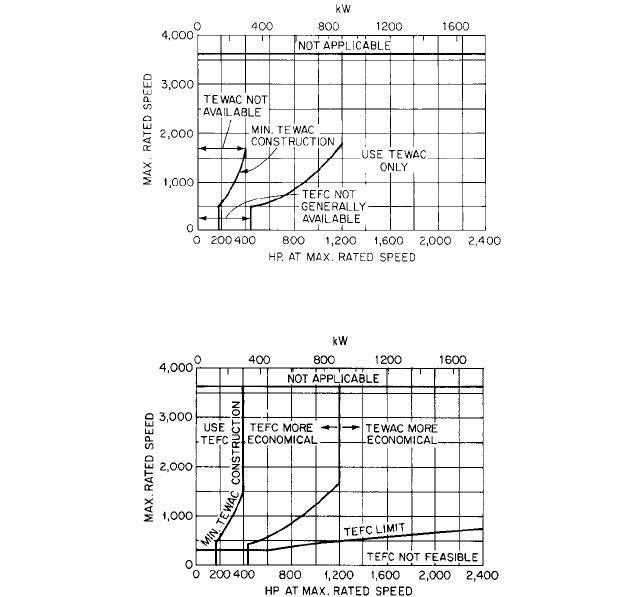
6.114 CHAPTER SIX
FIGURE 6A Approximate availability of totally enclosed vertical wound-rotor induction motors (General Electric)
FIGURE 6B Approximate availability of totally enclosed horizontal and vertical squirrel-cage induction motors
and horizontal wound-rotor induction motors. Wound-rotor induction motor speeds limited to 1800 rpm maximum
(General Electric).
*Trademark of General Electric Co.
Figure 6B delineates the left side, where totally enclosed fan-cooled (TEFC) construc-
tion should be used for horizontal wound-rotor induction motors because it is the only one
available, the middle area, where TEFC construction should be used because it is less
expensive than TEWAC construction, and, finally, the right side, where TEWAC construc-
tion is less expensive than TEFC construction. Again, motor speeds are limited to 1800
rpm synchronous.
Vertical wound-rotor induction motors are not available in explosion-proof construc-
tion, as their omission from Figure 6C implies.
Finally, the areas of availability and unavailability are delineated in Figure 6D for hor-
izontal wound-rotor induction motors in explosion-proof construction. Again, the curve ter-
minates at 1800 rpm synchronous speed for reasons already expressed.
Delineation of motor availability is an important criterion in drive selections. Table 2
presents significant data useful in drive selection.
Tirastat II* Secondary Controls This drive utilizes the same wound-rotor induction
motor and FVNR starter as the preceding, but substitutes a Tirastat II controller for the
